The State of The Rivers/Oceans/Water/Air
- Lisbeth
- Site Admin
- Posts: 67571
- Joined: Sat May 19, 2012 12:31 pm
- Country: Switzerland
- Location: Lugano
- Contact:
Re: The State of The Rivers/Oceans/Water/Air
Do they have to change all the patrol cars together? None of the others were working anymore? 
"Education is the most powerful weapon which you can use to change the world." Nelson Mandela
The desire for equality must never exceed the demands of knowledge
The desire for equality must never exceed the demands of knowledge
- Lisbeth
- Site Admin
- Posts: 67571
- Joined: Sat May 19, 2012 12:31 pm
- Country: Switzerland
- Location: Lugano
- Contact:
Re: The State of The Rivers/Oceans/Water/Air
UPL asked to explain how ‘Agent Orange’ war poison chemical ended up in Durban river
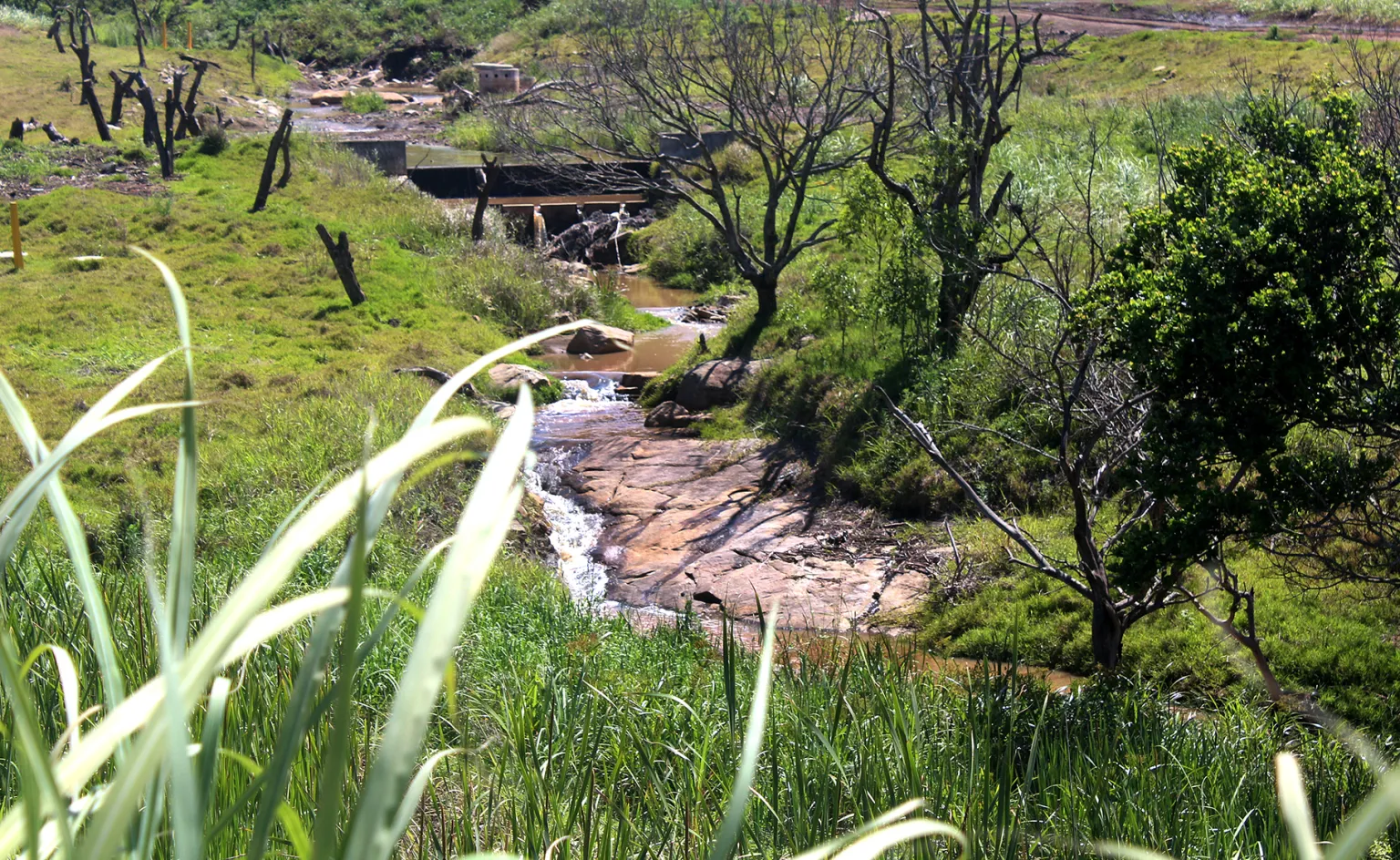
Water from the UPL chemical treatment plant flows into a tributary of the Ohlanga River in Durban (Photo: Tony Carnie)
By Tony Carnie | 11 Dec 2023
The banned pesticide 2,4,5-Trichlorophenoxyacetic acid has been found in samples collected by consultants looking into the aftermath of the UPL chemical fire. The company says it ‘never imported, stored, or traded this compound’.
___________________________________________________________________________________________________________________________
The discovery of a highly toxic, globally banned pesticide in water and soil samples north of Durban has heightened concerns around the poisonous aftermath of the UPL chemical inferno in July 2021.
The pesticide 2,4,5-Trichlorophenoxyacetic acid (2,4,5-T), was an ingredient of “Agent Orange” — a poisonous cocktail sprayed by the US military to defoliate jungles during the Vietnam War and later linked to a variety of serious human health and environmental impacts.
This pesticide was first banned domestically in parts of South Africa in the late 1980s after being linked to vegetable crop malformations in the Tala Valley in KwaZulu-Natal and also banned or severely restricted internationally through the Rotterdam Convention of 2004. Since 1984, it has been banned in India (UPL’s global headquarters).
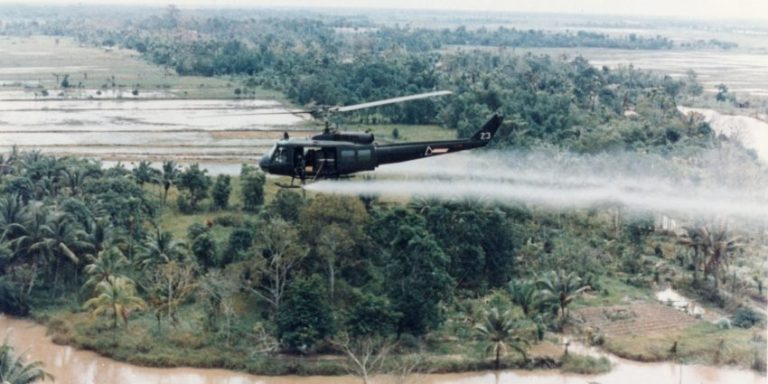
US military helicopter spraying Agent Orange over Vietnam (Photo: US Army / Wikimedia Commons)
However, it was not listed in a disclosure to the government by the Mumbai-based UPL group as being among the thousands of tonnes of chemicals that burnt or leaked next to residential areas alongside its warehouse in Cornubia, Durban.
Now it has come to light that significant levels of 2,4,5-T have been detected in several samples of soil and water in the immediate vicinity of the warehouse and in the Ohlanga Estuary over the past 2½ years — including samples collected directly from the fire-blackened floor of the Cornubia storehouse.
Daily Maverick has seen evidence confirming the presence of 2,4,5-T in numerous samples collected by UPL consultants, even though strict measures are in place globally to prohibit the import or export of this highly hazardous pesticide without specific notification to the Secretariat of the Rotterdam Convention. This is a global treaty signed by 165 countries to provide early warning to countries about a broad range of hazardous chemicals that are traded internationally.
Now UPL is under pressure to explain exactly how this chemical ended up polluting land and water in Durban.
The Cornubia Multi-Stakeholder Forum (MSF) — a civil society watchdog group established after the UPL warehouse was set alight during the July 2021 riots — says the presence of this pesticide in laboratory samples suggests that the substance entered South Africa unlawfully and that the country may have breached the Rotterdam Convention.
In a letter sent to several government departments last week (and copied to UPL management), Durban attorney and MSF convenor Jeremy Ridl said the discovery of 2,4,5-T in Durban would be referred to the Rotterdam Convention Secretariat in Switzerland for investigation.
It would also be reported to Marcos Orellana, the United Nations special rapporteur on toxics and human rights, who visited South Africa in August.
Ridl has also questioned why South Africa’s national Department of Environmental Affairs did not appear to have queried the discovery of a banned chemical in sample test results and taken appropriate action after tests dating back to 2021 revealed its presence inside or in close proximity to UPL’s storehouse.
Domestic legislation gazetted by Forestry, Fisheries and the Environment Minister Barbara Creecy provides for fines of up to R5-million or five years in jail for offenders who contravene the “Regulations to Domesticate the Requirements of the Rotterdam Convention on the Prior Informed Consent Procedure for Certain Hazardous Chemicals and Pesticides in International Trade”.
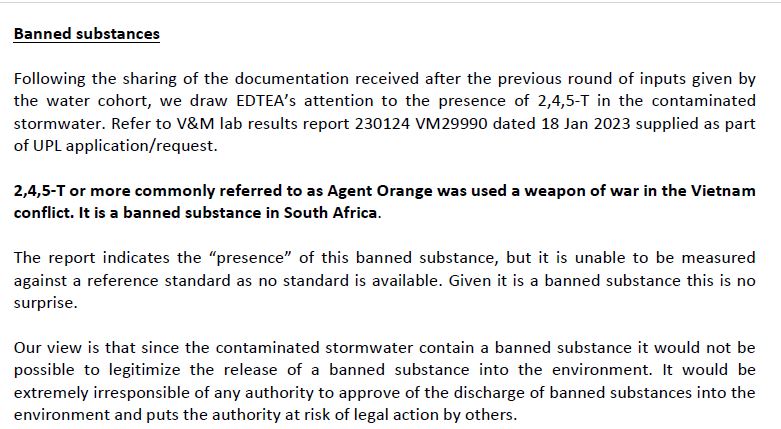
Extract of Ethekwini letter of 23 February 2023 to DEDTEA warning of banned pesticide 2,4,5-T.
UPL ‘never imported, stored or traded’ compound
In its response to our queries, UPL confirmed on Monday that 2,4,5-T had indeed been found near Cornubia.
However, company spokesperson Marcel Dreyer stated, “No quantity of 2,4,5-T was stored at Cornubia prior to the fire, and UPL South Africa has never imported, stored, or traded this compound.
“On the advice of expert toxicologists, we understand that the presence of this compound is explained by the high temperatures caused by the fire, which combusted other agrochemical products and unavoidably created this compound in exceptionally insignificant quantities.”
He also denied that UPL had ever infringed on the independence of its consultants and stated that the company’s ultraviolet/ozone chemical decontamination process was recommended by experts and was “working with complete consistency” and generating treated water “equivalent to drinking water”.
(See UPL’s full responding statement further below.)
However, Dreyer has not provided a copy of the company’s toxicology report explaining exactly how 2,4,5-T came to be found at Cornubia, nor quantified his statement that the banned chemical was only present in “exceptionally insignificant quantities”.
In fact, Daily Maverick understands that the banned pesticide levels exceeded 1,000 ng/g in several test results.
In his letter to the authorities, the MSF’s Ridl states, “At least one chemical on the 2017 list of chemicals that are banned or restricted for use in South Africa is present in most samples tested by GeoMeasure Group, GroundTruth Consulting and MER. The chemical 2,4,5-T [was] found to be present in almost all water samples tested by the consultants.”
Ridl also pointed to a decision guidance document by the convention secretariat, which states that 2,4,5-T is banned in most countries because it contains a very potent dioxin contaminant (2,3,7,8 TCDD) that is toxic even in minute quantities. It had been found to cause cancer or foetal abnormalities in all animal species it was tested on.
“The chemical is simply not allowed to enter South Africa, and for very good reason,“ said Ridl, noting that the MSF was “astounded” that toxicologists in the UPL specialist team did not appear to have commented on the presence of this substance in the many samples taken since the UPL fire.
Urgent interdict
Surprisingly, the results of these tests have only recently come to public attention against the backdrop of a high court case in which the eThekwini Municipality sought an urgent interdict against UPL.
UPL says it has commissioned a new treatment plant to detoxify pesticide-contaminated water from its old storehouse rather than dumping it at great cost at a landfill near KwaDukuza.
Rachel Evatt, UPL’s head of legal affairs for Africa, told the court that the company’s treatment process ensured that contaminated water was rendered “clean and non-threatening to the environment”.
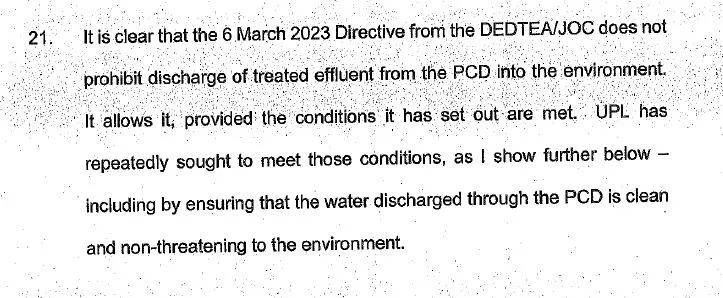
Extract of court affidavit by UPL Africa Head of Legal Rachel Evatt insisting that the company’s treated water is clean.
But senior eThekwini official Dr Andrew Mather told the court he was concerned that untreated water in UPL’s makeshift pollution control dam (PCD) had been on the point of overflowing at the end of October.
Despite UPL developing a “sophisticated” monitoring system to prevent this dam from overflowing into the Ohlanga River, it had overflowed at least twice after UPL allowed it to exceed the stipulated 30% storage capacity level, which was later revised to a 60% limit.
The court case is currently adjourned pending an interim court order, but behind the scenes, government officials have been engaged in acrimonious disputes over the best way of disposing of treated and untreated waste.
Earlier this month, the national Department of Water Affairs issued an “emergency directive” allowing UPL to discharge treated wastewater into a tributary of the Ohlanga River when its pollution control dam level exceeds 60%.
In another curious development, the KwaZulu-Natal Department of Environmental Affairs issued a pre-directive to the eThekwini Municipality and Tongaat-Hulett at the end of November, warning that they could be held in breach of their “duty of care” to the environment and a possible breach of environmental laws in connection with chemical pollution near the Cornubia site.
eThekwini and Tongaat-Hulett responded that the pre-directive appeared to be unreasonable and “illogical”, considering that the chemical pollution was caused by UPL, which was also directly responsible for the management and operation of the pollution control dam.
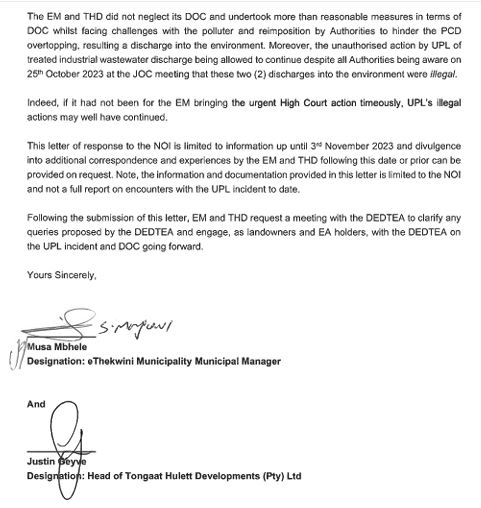
Extract of joint letter from Tongaat Hulett and Ethekwini Municipality to the KZN Department of Environmental Affairs.
Both the city and Tongaat Hulett had taken proactive steps to halt pollution from the UPL-controlled dam, and eThekwini briefed lawyers to prevent imminent pollution at the end of October — though the provincial Department of Environmental Affairs did not appear to have taken any action against UPL to avert this threat.
“Indeed, if it had not been for the eThekwini Municipality bringing the urgent High Court action timeously, UPL’s illegal actions may well have continued,” Durban City Manager Musa Mbhele and Tongaat Hulett Development head Justin Geyve said in a joint letter to senior provincial Department of Environmental Affairs official Dr Bonginkosi Dlamini.
MSF considering legal action
The MSF is also worried about the government’s apparent failure to finalise criminal charges against UPL and the “lack of cooperation and coordination” between several government authorities that sit together on a Joint Operations Committee (JOC).
This committee (including officials from national, provincial and local government) was appointed soon after the fire to coordinate the clean-up and rehabilitation of the polluted areas and to provide expert technical advice, including possible health impacts on people living in the vicinity.
But, according to the MSF, the government committee now met very infrequently and what was once a group of nearly 100 officials had dwindled to “only five or six officials”.
“From the correspondence, it appears that UPL deals directly and separately with officials in the three spheres, at times, bypassing the authority with the most proximate mandate. This is undermining the legitimacy of the process,” the forum said in a letter in March.
In its most recent letter of concern last week, sent to the JOC chairperson, Sabelo Ngcobo, the MSF civil society watchdog said it was essential that government authorities exercised their mandates in a coordinated and cooperative manner.
However, the JOC had failed to respond to the forum’s concerns. The fact that eThekwini resorted to an urgent court application while the Department of Water and Sanitation recently granted a directive to UPL to discharge treated water emphasised the forum’s concern that authorities were still not working cooperatively.
The MSF’s Ridl has also called for clarity on the role of UPL specialist environmental and technical consultants.
“They might be appointed by UPL, but they must be independent and accountable to the authorities, and therefore the public. It is becoming clear that UPL considers the consultants to be under their control and answerable to them, first and foremost.
“This compromises the independence of the specialists and undermines public confidence that the true state of affairs is being disclosed. If the authorities have ceded control of the process to UPL, the public needs to know,” the forum suggested.
The MSF has also questioned the effectiveness of the UPL pollution treatment process, alleging that it had “not functioned consistently efficiently and cannot be relied upon.
“There are no time-series tests or repeatability tests to verify that the plant is able to yield a consistent quality of water, given the varying concentrations of contaminants in the PCD, depending on rainfall and other factors.
“In assessing whether the water is safe to discharge into the natural environment, testing has been required for only those substances that UPL is legally permitted to have or is willing to disclose.
“The UPL representative has only been able to say ‘to the best of my knowledge’ no banned substances were present in the warehouse prior to the fire. Even this qualification is questionable, given the laboratory analyses that show the presence of the banned chemical 2,4,5-T.”
No stakeholder consultation
The forum further notes that the choice of treatment plant was made without stakeholder consultation. Though the MSF had long advocated for onsite treatment of the contents of the PCD, using the most appropriate and best technology, several questions arose:
“What alternative technologies were considered? Was reverse osmosis considered? Why has the treatment plant failed at times or not functioned correctly? Do all the specialist consultants, within their fields of expertise agree that it is safe to discharge treated water into the tributary? Are all the authorities in agreement that the water is safe to discharge into the natural environment?”
Under these circumstances, the MSF considered the directive compelling UPL to discharge treated water into the Ohlanga tributary to be unlawful.
“While it was not intended that the MSF would be a vehicle for litigation, given the present threats to the environment and surrounding communities, it is considering a restructure to enable it to bring interdict proceedings against UPL and the authorities.”
The national Department of Water Affairs and Sanitation, the Department of Forestry, Fisheries and the Environment and eThekwini Municipality had not responded to Daily Maverick requests for comment sent on 8 December. DM
UPL’s full response to Daily Maverick’s questions
UPL’s view remains that this matter must be dealt with by the relevant authorities and in the appropriate forum, but there are several inaccuracies in your questions which must be addressed ahead of publication.
As indicated in our letter to your Editor in Chief, Mr Branko Brkic, we remind the Daily Maverick of its obligations under the Press Code of The Press Council of South Africa. Please see below a statement from UPL which should be published in full:
“No quantity of 2,4,5-T was stored at Cornubia prior to the fire, and UPL South Africa has never imported, stored, or traded this compound. On the advice of expert toxicologists, we understand that the presence of this compound is explained by the high temperatures caused by the fire, which combusted other agrochemical products and unavoidably created this compound in exceptionally insignificant quantities.
“UPL has never infringed on the independence of any consultant. The National Environmental Management Act ‘Section 30 Directive’ issued by the Department of Forestry, Fisheries and the Environment compels UPL to appoint and remunerate environmental consultants, but we neither exercise nor seek any influence over their work.
“Our UV/Ozone treatment process was recommended by experts and is working with complete consistency. Water treated from our Pollution Control Dam (PCD) is now registering between a 99-100% reduction in residual contamination, meeting Class 1 discharge limits which is equivalent to drinking water.
“We will continue to work closely with all parties, including with the Multi-Stakeholder Forum, in the appropriate forum, and will continue to provide updates on the environmental rehabilitation programme that has been underway since 2021.”
Marcel Dreyer
UPL Regional Head Africa, Middle East
The provincial Department of Environmental Affairs’ full response to MSF’s concerns
We wish to confirm receipt of this correspondence from Mr Ridl. We request that you afford us time to consider and respond to Mr Ridl’s letter.
We do not believe that it will be appropriate for us to respond to Mr Ridl via media. However, we undertake to update you once we have responded to Mr Ridl.
In addition, we wish to indicate that the decision by the department to issue pre-directives to both eThekwini and THD is informed by the legislative mandate.
As guided by the laws of the country, the department is obligated to hold both institutions to account in terms of their responsibilities as owners of the pieces of land in question and as holders of the authorisations issued to them in relation to the Cornubia integrated development.
The decision to issue these pre-directives was taken after due consideration and the department stands by its decision in this regard. DM

Water from the UPL chemical treatment plant flows into a tributary of the Ohlanga River in Durban (Photo: Tony Carnie)
By Tony Carnie | 11 Dec 2023
The banned pesticide 2,4,5-Trichlorophenoxyacetic acid has been found in samples collected by consultants looking into the aftermath of the UPL chemical fire. The company says it ‘never imported, stored, or traded this compound’.
___________________________________________________________________________________________________________________________
The discovery of a highly toxic, globally banned pesticide in water and soil samples north of Durban has heightened concerns around the poisonous aftermath of the UPL chemical inferno in July 2021.
The pesticide 2,4,5-Trichlorophenoxyacetic acid (2,4,5-T), was an ingredient of “Agent Orange” — a poisonous cocktail sprayed by the US military to defoliate jungles during the Vietnam War and later linked to a variety of serious human health and environmental impacts.
This pesticide was first banned domestically in parts of South Africa in the late 1980s after being linked to vegetable crop malformations in the Tala Valley in KwaZulu-Natal and also banned or severely restricted internationally through the Rotterdam Convention of 2004. Since 1984, it has been banned in India (UPL’s global headquarters).

US military helicopter spraying Agent Orange over Vietnam (Photo: US Army / Wikimedia Commons)
However, it was not listed in a disclosure to the government by the Mumbai-based UPL group as being among the thousands of tonnes of chemicals that burnt or leaked next to residential areas alongside its warehouse in Cornubia, Durban.
Now it has come to light that significant levels of 2,4,5-T have been detected in several samples of soil and water in the immediate vicinity of the warehouse and in the Ohlanga Estuary over the past 2½ years — including samples collected directly from the fire-blackened floor of the Cornubia storehouse.
Daily Maverick has seen evidence confirming the presence of 2,4,5-T in numerous samples collected by UPL consultants, even though strict measures are in place globally to prohibit the import or export of this highly hazardous pesticide without specific notification to the Secretariat of the Rotterdam Convention. This is a global treaty signed by 165 countries to provide early warning to countries about a broad range of hazardous chemicals that are traded internationally.
Now UPL is under pressure to explain exactly how this chemical ended up polluting land and water in Durban.
The Cornubia Multi-Stakeholder Forum (MSF) — a civil society watchdog group established after the UPL warehouse was set alight during the July 2021 riots — says the presence of this pesticide in laboratory samples suggests that the substance entered South Africa unlawfully and that the country may have breached the Rotterdam Convention.
In a letter sent to several government departments last week (and copied to UPL management), Durban attorney and MSF convenor Jeremy Ridl said the discovery of 2,4,5-T in Durban would be referred to the Rotterdam Convention Secretariat in Switzerland for investigation.
It would also be reported to Marcos Orellana, the United Nations special rapporteur on toxics and human rights, who visited South Africa in August.
Ridl has also questioned why South Africa’s national Department of Environmental Affairs did not appear to have queried the discovery of a banned chemical in sample test results and taken appropriate action after tests dating back to 2021 revealed its presence inside or in close proximity to UPL’s storehouse.
Domestic legislation gazetted by Forestry, Fisheries and the Environment Minister Barbara Creecy provides for fines of up to R5-million or five years in jail for offenders who contravene the “Regulations to Domesticate the Requirements of the Rotterdam Convention on the Prior Informed Consent Procedure for Certain Hazardous Chemicals and Pesticides in International Trade”.

Extract of Ethekwini letter of 23 February 2023 to DEDTEA warning of banned pesticide 2,4,5-T.
UPL ‘never imported, stored or traded’ compound
In its response to our queries, UPL confirmed on Monday that 2,4,5-T had indeed been found near Cornubia.
However, company spokesperson Marcel Dreyer stated, “No quantity of 2,4,5-T was stored at Cornubia prior to the fire, and UPL South Africa has never imported, stored, or traded this compound.
“On the advice of expert toxicologists, we understand that the presence of this compound is explained by the high temperatures caused by the fire, which combusted other agrochemical products and unavoidably created this compound in exceptionally insignificant quantities.”
He also denied that UPL had ever infringed on the independence of its consultants and stated that the company’s ultraviolet/ozone chemical decontamination process was recommended by experts and was “working with complete consistency” and generating treated water “equivalent to drinking water”.
(See UPL’s full responding statement further below.)
However, Dreyer has not provided a copy of the company’s toxicology report explaining exactly how 2,4,5-T came to be found at Cornubia, nor quantified his statement that the banned chemical was only present in “exceptionally insignificant quantities”.
In fact, Daily Maverick understands that the banned pesticide levels exceeded 1,000 ng/g in several test results.
In his letter to the authorities, the MSF’s Ridl states, “At least one chemical on the 2017 list of chemicals that are banned or restricted for use in South Africa is present in most samples tested by GeoMeasure Group, GroundTruth Consulting and MER. The chemical 2,4,5-T [was] found to be present in almost all water samples tested by the consultants.”
Ridl also pointed to a decision guidance document by the convention secretariat, which states that 2,4,5-T is banned in most countries because it contains a very potent dioxin contaminant (2,3,7,8 TCDD) that is toxic even in minute quantities. It had been found to cause cancer or foetal abnormalities in all animal species it was tested on.
“The chemical is simply not allowed to enter South Africa, and for very good reason,“ said Ridl, noting that the MSF was “astounded” that toxicologists in the UPL specialist team did not appear to have commented on the presence of this substance in the many samples taken since the UPL fire.
Urgent interdict
Surprisingly, the results of these tests have only recently come to public attention against the backdrop of a high court case in which the eThekwini Municipality sought an urgent interdict against UPL.
UPL says it has commissioned a new treatment plant to detoxify pesticide-contaminated water from its old storehouse rather than dumping it at great cost at a landfill near KwaDukuza.
Rachel Evatt, UPL’s head of legal affairs for Africa, told the court that the company’s treatment process ensured that contaminated water was rendered “clean and non-threatening to the environment”.

Extract of court affidavit by UPL Africa Head of Legal Rachel Evatt insisting that the company’s treated water is clean.
But senior eThekwini official Dr Andrew Mather told the court he was concerned that untreated water in UPL’s makeshift pollution control dam (PCD) had been on the point of overflowing at the end of October.
Despite UPL developing a “sophisticated” monitoring system to prevent this dam from overflowing into the Ohlanga River, it had overflowed at least twice after UPL allowed it to exceed the stipulated 30% storage capacity level, which was later revised to a 60% limit.
The court case is currently adjourned pending an interim court order, but behind the scenes, government officials have been engaged in acrimonious disputes over the best way of disposing of treated and untreated waste.
Earlier this month, the national Department of Water Affairs issued an “emergency directive” allowing UPL to discharge treated wastewater into a tributary of the Ohlanga River when its pollution control dam level exceeds 60%.
In another curious development, the KwaZulu-Natal Department of Environmental Affairs issued a pre-directive to the eThekwini Municipality and Tongaat-Hulett at the end of November, warning that they could be held in breach of their “duty of care” to the environment and a possible breach of environmental laws in connection with chemical pollution near the Cornubia site.
eThekwini and Tongaat-Hulett responded that the pre-directive appeared to be unreasonable and “illogical”, considering that the chemical pollution was caused by UPL, which was also directly responsible for the management and operation of the pollution control dam.

Extract of joint letter from Tongaat Hulett and Ethekwini Municipality to the KZN Department of Environmental Affairs.
Both the city and Tongaat Hulett had taken proactive steps to halt pollution from the UPL-controlled dam, and eThekwini briefed lawyers to prevent imminent pollution at the end of October — though the provincial Department of Environmental Affairs did not appear to have taken any action against UPL to avert this threat.
“Indeed, if it had not been for the eThekwini Municipality bringing the urgent High Court action timeously, UPL’s illegal actions may well have continued,” Durban City Manager Musa Mbhele and Tongaat Hulett Development head Justin Geyve said in a joint letter to senior provincial Department of Environmental Affairs official Dr Bonginkosi Dlamini.
MSF considering legal action
The MSF is also worried about the government’s apparent failure to finalise criminal charges against UPL and the “lack of cooperation and coordination” between several government authorities that sit together on a Joint Operations Committee (JOC).
This committee (including officials from national, provincial and local government) was appointed soon after the fire to coordinate the clean-up and rehabilitation of the polluted areas and to provide expert technical advice, including possible health impacts on people living in the vicinity.
But, according to the MSF, the government committee now met very infrequently and what was once a group of nearly 100 officials had dwindled to “only five or six officials”.
“From the correspondence, it appears that UPL deals directly and separately with officials in the three spheres, at times, bypassing the authority with the most proximate mandate. This is undermining the legitimacy of the process,” the forum said in a letter in March.
In its most recent letter of concern last week, sent to the JOC chairperson, Sabelo Ngcobo, the MSF civil society watchdog said it was essential that government authorities exercised their mandates in a coordinated and cooperative manner.
However, the JOC had failed to respond to the forum’s concerns. The fact that eThekwini resorted to an urgent court application while the Department of Water and Sanitation recently granted a directive to UPL to discharge treated water emphasised the forum’s concern that authorities were still not working cooperatively.
The MSF’s Ridl has also called for clarity on the role of UPL specialist environmental and technical consultants.
“They might be appointed by UPL, but they must be independent and accountable to the authorities, and therefore the public. It is becoming clear that UPL considers the consultants to be under their control and answerable to them, first and foremost.
“This compromises the independence of the specialists and undermines public confidence that the true state of affairs is being disclosed. If the authorities have ceded control of the process to UPL, the public needs to know,” the forum suggested.
The MSF has also questioned the effectiveness of the UPL pollution treatment process, alleging that it had “not functioned consistently efficiently and cannot be relied upon.
“There are no time-series tests or repeatability tests to verify that the plant is able to yield a consistent quality of water, given the varying concentrations of contaminants in the PCD, depending on rainfall and other factors.
“In assessing whether the water is safe to discharge into the natural environment, testing has been required for only those substances that UPL is legally permitted to have or is willing to disclose.
“The UPL representative has only been able to say ‘to the best of my knowledge’ no banned substances were present in the warehouse prior to the fire. Even this qualification is questionable, given the laboratory analyses that show the presence of the banned chemical 2,4,5-T.”
No stakeholder consultation
The forum further notes that the choice of treatment plant was made without stakeholder consultation. Though the MSF had long advocated for onsite treatment of the contents of the PCD, using the most appropriate and best technology, several questions arose:
“What alternative technologies were considered? Was reverse osmosis considered? Why has the treatment plant failed at times or not functioned correctly? Do all the specialist consultants, within their fields of expertise agree that it is safe to discharge treated water into the tributary? Are all the authorities in agreement that the water is safe to discharge into the natural environment?”
Under these circumstances, the MSF considered the directive compelling UPL to discharge treated water into the Ohlanga tributary to be unlawful.
“While it was not intended that the MSF would be a vehicle for litigation, given the present threats to the environment and surrounding communities, it is considering a restructure to enable it to bring interdict proceedings against UPL and the authorities.”
The national Department of Water Affairs and Sanitation, the Department of Forestry, Fisheries and the Environment and eThekwini Municipality had not responded to Daily Maverick requests for comment sent on 8 December. DM
UPL’s full response to Daily Maverick’s questions
UPL’s view remains that this matter must be dealt with by the relevant authorities and in the appropriate forum, but there are several inaccuracies in your questions which must be addressed ahead of publication.
As indicated in our letter to your Editor in Chief, Mr Branko Brkic, we remind the Daily Maverick of its obligations under the Press Code of The Press Council of South Africa. Please see below a statement from UPL which should be published in full:
“No quantity of 2,4,5-T was stored at Cornubia prior to the fire, and UPL South Africa has never imported, stored, or traded this compound. On the advice of expert toxicologists, we understand that the presence of this compound is explained by the high temperatures caused by the fire, which combusted other agrochemical products and unavoidably created this compound in exceptionally insignificant quantities.
“UPL has never infringed on the independence of any consultant. The National Environmental Management Act ‘Section 30 Directive’ issued by the Department of Forestry, Fisheries and the Environment compels UPL to appoint and remunerate environmental consultants, but we neither exercise nor seek any influence over their work.
“Our UV/Ozone treatment process was recommended by experts and is working with complete consistency. Water treated from our Pollution Control Dam (PCD) is now registering between a 99-100% reduction in residual contamination, meeting Class 1 discharge limits which is equivalent to drinking water.
“We will continue to work closely with all parties, including with the Multi-Stakeholder Forum, in the appropriate forum, and will continue to provide updates on the environmental rehabilitation programme that has been underway since 2021.”
Marcel Dreyer
UPL Regional Head Africa, Middle East
The provincial Department of Environmental Affairs’ full response to MSF’s concerns
We wish to confirm receipt of this correspondence from Mr Ridl. We request that you afford us time to consider and respond to Mr Ridl’s letter.
We do not believe that it will be appropriate for us to respond to Mr Ridl via media. However, we undertake to update you once we have responded to Mr Ridl.
In addition, we wish to indicate that the decision by the department to issue pre-directives to both eThekwini and THD is informed by the legislative mandate.
As guided by the laws of the country, the department is obligated to hold both institutions to account in terms of their responsibilities as owners of the pieces of land in question and as holders of the authorisations issued to them in relation to the Cornubia integrated development.
The decision to issue these pre-directives was taken after due consideration and the department stands by its decision in this regard. DM
"Education is the most powerful weapon which you can use to change the world." Nelson Mandela
The desire for equality must never exceed the demands of knowledge
The desire for equality must never exceed the demands of knowledge
- Lisbeth
- Site Admin
- Posts: 67571
- Joined: Sat May 19, 2012 12:31 pm
- Country: Switzerland
- Location: Lugano
- Contact:
Re: The State of The Rivers/Oceans/Water/Air
After bacterial infections, Strand beachgoers call for effective water-quality flag system
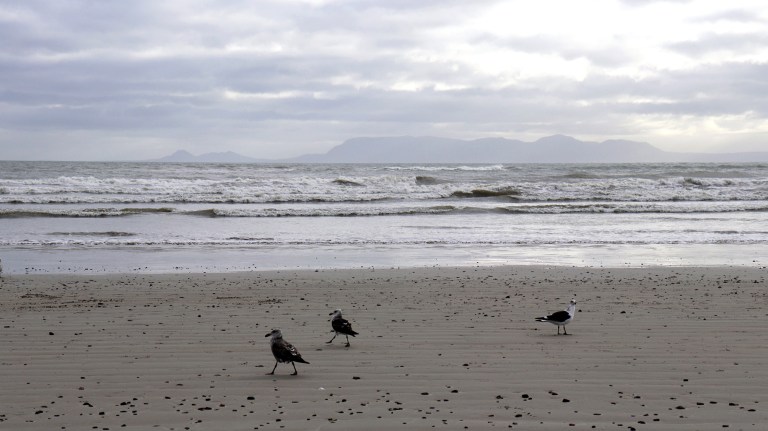
A number of people have reported becoming ill after swimming in some Cape beaches with the City of Cape Town now being called on to warn beachgoers more accurately about potential health risks at its beaches. (Photo: Kristin Engel)
By Kristin Engel | 23 Jan 2024
Beachgoers have contracted lingering infections linked to high bacteria counts in the water at Strand Beach. Calls are mounting for clearer and more frequent communication of coastal water-quality status.
______________________________________________________________________________________________________________________
In interviews with Daily Maverick, beachgoers have shared their experiences of becoming extremely ill with lingering infections after using Strand Beach, Cape Town, for training and recreation. Experts believe the infections are caused by high bacteria counts in the water due to sewage contamination.
Most of the beachgoers who spoke to Daily Maverick were aware that there were problems with the water quality at the time caused by the ailing Ou Trappies sewer line. Many had seen signs at Strand warning beachgoers not to enter the water but were unaware of the severity of the health risks they faced.
When a coastal pollution incident is detected, the City of Cape Town has a response protocol to swiftly contain and rectify the situation, which entails the temporary closure, with signage, of the affected section of the beach until the water is safe again.
The city says all water-quality information is available on its coastal water-quality webpage, and physical signage is used when a site is affected. However, the city’s water-quality review on the webpage has been criticised for displaying incomplete information that is not updated regularly.
In the past, the city’s water-quality review assigned an overall risk level for each recreational node, but this has been missing from recent reviews.
Beachgoers say the city’s measures are not sufficient as the signage is often a flimsy board which is easily blown away or stolen. They complain that they do not have accurate and periodical information on the water quality at Strand and other beaches.
Daily Maverick has previously reported that data from the City of Cape Town’s website have shown “poor” water quality at a number of the city’s most popular beaches, including Strand.
Water-quality flag system
Jamii Hamlin, who represents surfers, lifesavers and other beach users in Strand and Helderberg, has long stated that the warning system to advise the public of beach closures and potential health risks was not effective.
“Unfortunately, Strand is not alone, as poor water quality remains the mean average for most of the recreational beaches around the Peninsula and thus I believe if the city were to adopt a water-quality flag system it would greatly reflect the accountability the government continually strives for,” Hamlin said.
Bays of Sewage is a community group created to raise awareness about the impacts of Cape Town’s marine sewage outfalls at Hout Bay, Camps Bay, and Green Point on humans and marine life. The community group advocates for better notification and communication of the status of coastal water quality around Cape Town.
Byron Herbert from Bays of Sewage has encouraged beachgoers to report potential sewage-related illnesses to data@baysofsewage.co.za as they were developing a database to raise awareness about illnesses caused by poor coastal water quality.
Mark Jackson, who filmed the Bays of Sewage documentary, said part of the problem was that politicians value public perception more highly than public health.
“This is why, often, when there is an incident of sewage-beach contamination, the city’s only response might be to just erect a few signs. But we know these signs are ineffective, and that many beach users miss or ignore them,” he said.
Read more in Daily Maverick: Cape Town’s beaches may be more hazardous to health than they seem, according to sewage test results
Water treatment expert Professor Leslie Petrik of the Department of Chemistry at the University of the Western Cape, said the bacterial counts at Strand and many other beaches had been chronically poor.
Most of the bacteria in samples taken from water bodies by Petrik’s team have been highly antibiotic-resistant, meaning they do not die when infections are treated with most frontline antibiotics.
“There is a clear link between the sewage-contaminated seawater and picking up an infection that is resistant. Our studies indicate that the chemical contamination in sewage is implicated in developing antibiotic-resistant genes in microbes that survive contact. So a wound occurring in contaminated seawater would very likely be infected with such resistant organisms,” Petrik said.
Jo Barnes, a senior lecturer emeritus in epidemiology and community health at Stellenbosch University, said: “I am of the opinion that a water-quality flag system based on risk should be displayed at each beach, based on weekly or monthly average quality, and the public educated about the risks of swimming around our coastline.”
Responding to this suggestion, City of Cape Town coastal manager Gregg Oelofse said that they would need “lots of signs to explain the flags and colours, and what they mean to the people. We do this with our shark spotting flags and still people get confused after 16 years.”
Six days in ICU
Jean Degenaar, a champion open-water swimmer from the Warrior Swimmers group in Strand, has been regularly swimming from Strand Surf Lifesavers Club to Hibernian Towers and back for about four years. Between the end of September and November 2023, Degenaar suffered from a lack of energy and sinusitis.
She was hospitalised on 13 November for two weeks with severe abdominal pain and vomiting. The official diagnosis was pancreatitis and she spent six days in the ICU.
“My lungs filled up with fluid and I had to have drains in both. I was in bad shape, taking strong antibiotics and morphine for pain. I think my recovery was due to being fit. But I can only put this episode down to swimming in poor water quality. The E. coli levels at that time were pretty high,” she said.
After this harrowing experience, Degenaar no longer swims in the ocean and will use pools until she is sure the coastal water conditions are pristine. She said the city needed to improve its water-quality information system and also advocated a water-quality flag system.
Bacterial infections
Craig Hoblyn, who has been swimming, surfing and diving at Strand Beach for more than 30 years, became violently ill with fever, chills, stomach cramping, vomiting, diarrhoea and nausea on 23 September. He was admitted to the Hermanus Mediclinic ER the following morning.
“I had blood tests … which confirmed a severe bacterial infection — the doctor attributed the infection to raw sewage exposure in the Strand ocean water. I have been on antibiotics — three weeks on, I was still not fully recovered.”
Hoblyn said there was a warning board on the beach when he surfed, but he never imagined he would become so ill.
“We were quite aware … that the water quality at Strand had become quite poor. I mean, you could literally see it, smell it; it was quite evident but you sort of chose to go ahead or not. They did put up a sign that the water was unfit for recreational use. It was a small board in the corner that I think later on blew away or was rubbed out or something,” he said.
Read more in Daily Maverick: Barbara Creecy chides City of Cape Town over ‘inadequate’ public engagement on sewage pumped into sea
Another surfer, Emmanuel (who did not want his surname published), expressed concerns about the lack of public awareness and warning systems regarding water quality at Strand Beach.
In May 2023, he contracted an antibiotic-resistant bacterial infection with high counts of E. coli and faecal bacteria after cutting his foot in the water at Strand Beach. This is according to a bacterial culture test by PathCare, dated 19 June 2023, and seen by Daily Maverick.
The initial treatment included disinfection, stitches, a five-day antibiotic course and antibacterial gel. Despite this, the wound remained infected, leading to two additional five-day antibiotic courses. A test revealed the presence of E. coli and faecal bacteria. Targeted antibiotics were prescribed, and the infection finally subsided almost two months after the initial laceration.
Poor water quality
Strand Beach is one of Cape Town’s beaches that is plagued by chronic water-quality problems, and this has been exacerbated by ailing and ageing sewage infrastructure in the area. There have been 28 repairs to the Ou Trappies sewer line over the past four years, which has resulted in sewage being discharged into the ocean. Upgrades to the pipeline are being finalised and will continue until 2026.
Read more in Daily Maverick: Western Cape’s Strand residents and surfers up in arms over sewage flowing into streets and ocean
The City of Cape Town’s Oelofse, shared the city’s E. coli (sewage bacteria) data for Strand in September 2023, which is when some people using the beach became ill. On 8 September, the city closed the beach to all recreational users because of the Ou Trappies sewer line failure.
Oelofse said the city did not have data for enterococci (bacteria found in high concentrations in human faeces), at the time E. coli should not exceed 250 colony-forming units (CFU) per 100ml. On 20 September, the E. coli count at Strand Beach was more than double that, at 602cfu per 100ml.
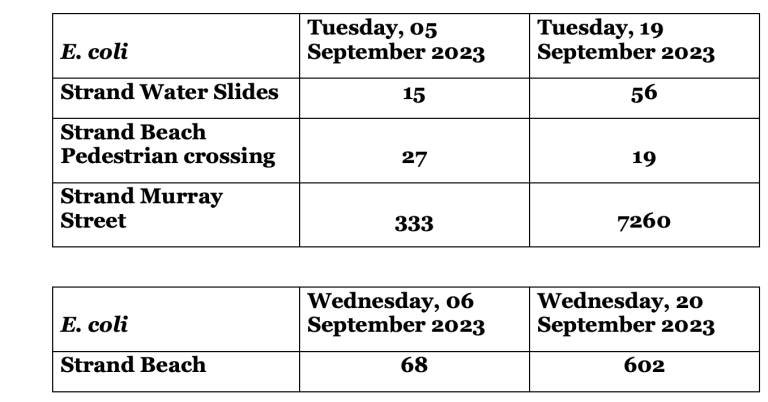
According to the city’s water-quality review, the enterococci count for Strand Beach was 20cfu per 100ml on 8 November, 50cfu per 100ml on 22 November and 4cfu per 100ml on 13 December. Water with a concentration of below 35cfu per 100ml is considered safe for recreational purposes.
The city’s most recent enterococci results for Strand (10 January) showed less than 1cfu per 100ml — indicative of a steady improvement in the water quality.
Oelofse said, “Water-quality data is not real-time. City samples are taken twice a month and used to calculate a risk category — water quality is not a real-time reading and uses past data to indicate risk. This is the same all over the world.”
However, beachgoers have argued that the City’s bi-monthly water sampling is unreliable because extended periods of poor water quality resulting from changing wind direction, currents and storms could be overlooked in these readings.
Response from the city
In response to the experiences of the three beachgoers who became sick, City of Cape Town spokesperson Luthando Tyhalibongo said: “The context of these incidents (months after the fact) and at one location only, is extremely important.
“I want to caution upfront that these incidents cannot be used as a fair and reasonable indication of Cape Town’s coastal water quality in general, at this point in time.”
Tyhalibongo said the city’s Coastal Management Branch had contacted some of the individuals who raised concerns. One of them reportedly saw a “Water closed to all” sign but decided to surf anyway, while another swam in September when swimming at the beach was prohibited due to the Ou Trappies sewer line failure, and this is when she became unwell.
Tyhalibongo described it as “a huge accomplishment” that all of Cape Town’s beaches had remained open during the festive period.
However, earlier this month, Camps Bay’s Blue Flag status was temporarily lowered as a result of a sewage spill from a nearby toilet block.
A senior city official told Daily Maverick that if the water quality was poor and the data reflected that, then the city would have no problem warning of the risks of swimming, but “the data doesn’t support that narrative at all. Repeated tests show that water quality at key recreational nodes is really good. This should be good news for people.”
Tyhalibongo said, “In areas with chronic pollution, or close to pollution sources such as river mouths or stormwater drains that may contaminate coastal waters, there is permanent formal pollution signage in place. However … the public often ignores the signage.
“The city cannot accept responsibility for those who ignore the signage on site. Still, the city is always open to working with local stakeholders to raise further awareness.” DM

A number of people have reported becoming ill after swimming in some Cape beaches with the City of Cape Town now being called on to warn beachgoers more accurately about potential health risks at its beaches. (Photo: Kristin Engel)
By Kristin Engel | 23 Jan 2024
Beachgoers have contracted lingering infections linked to high bacteria counts in the water at Strand Beach. Calls are mounting for clearer and more frequent communication of coastal water-quality status.
______________________________________________________________________________________________________________________
In interviews with Daily Maverick, beachgoers have shared their experiences of becoming extremely ill with lingering infections after using Strand Beach, Cape Town, for training and recreation. Experts believe the infections are caused by high bacteria counts in the water due to sewage contamination.
Most of the beachgoers who spoke to Daily Maverick were aware that there were problems with the water quality at the time caused by the ailing Ou Trappies sewer line. Many had seen signs at Strand warning beachgoers not to enter the water but were unaware of the severity of the health risks they faced.
When a coastal pollution incident is detected, the City of Cape Town has a response protocol to swiftly contain and rectify the situation, which entails the temporary closure, with signage, of the affected section of the beach until the water is safe again.
The city says all water-quality information is available on its coastal water-quality webpage, and physical signage is used when a site is affected. However, the city’s water-quality review on the webpage has been criticised for displaying incomplete information that is not updated regularly.
In the past, the city’s water-quality review assigned an overall risk level for each recreational node, but this has been missing from recent reviews.
Beachgoers say the city’s measures are not sufficient as the signage is often a flimsy board which is easily blown away or stolen. They complain that they do not have accurate and periodical information on the water quality at Strand and other beaches.
Daily Maverick has previously reported that data from the City of Cape Town’s website have shown “poor” water quality at a number of the city’s most popular beaches, including Strand.
Water-quality flag system
Jamii Hamlin, who represents surfers, lifesavers and other beach users in Strand and Helderberg, has long stated that the warning system to advise the public of beach closures and potential health risks was not effective.
“Unfortunately, Strand is not alone, as poor water quality remains the mean average for most of the recreational beaches around the Peninsula and thus I believe if the city were to adopt a water-quality flag system it would greatly reflect the accountability the government continually strives for,” Hamlin said.
Bays of Sewage is a community group created to raise awareness about the impacts of Cape Town’s marine sewage outfalls at Hout Bay, Camps Bay, and Green Point on humans and marine life. The community group advocates for better notification and communication of the status of coastal water quality around Cape Town.
Byron Herbert from Bays of Sewage has encouraged beachgoers to report potential sewage-related illnesses to data@baysofsewage.co.za as they were developing a database to raise awareness about illnesses caused by poor coastal water quality.
Mark Jackson, who filmed the Bays of Sewage documentary, said part of the problem was that politicians value public perception more highly than public health.
“This is why, often, when there is an incident of sewage-beach contamination, the city’s only response might be to just erect a few signs. But we know these signs are ineffective, and that many beach users miss or ignore them,” he said.
Read more in Daily Maverick: Cape Town’s beaches may be more hazardous to health than they seem, according to sewage test results
Water treatment expert Professor Leslie Petrik of the Department of Chemistry at the University of the Western Cape, said the bacterial counts at Strand and many other beaches had been chronically poor.
Most of the bacteria in samples taken from water bodies by Petrik’s team have been highly antibiotic-resistant, meaning they do not die when infections are treated with most frontline antibiotics.
“There is a clear link between the sewage-contaminated seawater and picking up an infection that is resistant. Our studies indicate that the chemical contamination in sewage is implicated in developing antibiotic-resistant genes in microbes that survive contact. So a wound occurring in contaminated seawater would very likely be infected with such resistant organisms,” Petrik said.
Jo Barnes, a senior lecturer emeritus in epidemiology and community health at Stellenbosch University, said: “I am of the opinion that a water-quality flag system based on risk should be displayed at each beach, based on weekly or monthly average quality, and the public educated about the risks of swimming around our coastline.”
Responding to this suggestion, City of Cape Town coastal manager Gregg Oelofse said that they would need “lots of signs to explain the flags and colours, and what they mean to the people. We do this with our shark spotting flags and still people get confused after 16 years.”
Six days in ICU
Jean Degenaar, a champion open-water swimmer from the Warrior Swimmers group in Strand, has been regularly swimming from Strand Surf Lifesavers Club to Hibernian Towers and back for about four years. Between the end of September and November 2023, Degenaar suffered from a lack of energy and sinusitis.
She was hospitalised on 13 November for two weeks with severe abdominal pain and vomiting. The official diagnosis was pancreatitis and she spent six days in the ICU.
“My lungs filled up with fluid and I had to have drains in both. I was in bad shape, taking strong antibiotics and morphine for pain. I think my recovery was due to being fit. But I can only put this episode down to swimming in poor water quality. The E. coli levels at that time were pretty high,” she said.
After this harrowing experience, Degenaar no longer swims in the ocean and will use pools until she is sure the coastal water conditions are pristine. She said the city needed to improve its water-quality information system and also advocated a water-quality flag system.
Bacterial infections
Craig Hoblyn, who has been swimming, surfing and diving at Strand Beach for more than 30 years, became violently ill with fever, chills, stomach cramping, vomiting, diarrhoea and nausea on 23 September. He was admitted to the Hermanus Mediclinic ER the following morning.
“I had blood tests … which confirmed a severe bacterial infection — the doctor attributed the infection to raw sewage exposure in the Strand ocean water. I have been on antibiotics — three weeks on, I was still not fully recovered.”
Hoblyn said there was a warning board on the beach when he surfed, but he never imagined he would become so ill.
“We were quite aware … that the water quality at Strand had become quite poor. I mean, you could literally see it, smell it; it was quite evident but you sort of chose to go ahead or not. They did put up a sign that the water was unfit for recreational use. It was a small board in the corner that I think later on blew away or was rubbed out or something,” he said.
Read more in Daily Maverick: Barbara Creecy chides City of Cape Town over ‘inadequate’ public engagement on sewage pumped into sea
Another surfer, Emmanuel (who did not want his surname published), expressed concerns about the lack of public awareness and warning systems regarding water quality at Strand Beach.
In May 2023, he contracted an antibiotic-resistant bacterial infection with high counts of E. coli and faecal bacteria after cutting his foot in the water at Strand Beach. This is according to a bacterial culture test by PathCare, dated 19 June 2023, and seen by Daily Maverick.
The initial treatment included disinfection, stitches, a five-day antibiotic course and antibacterial gel. Despite this, the wound remained infected, leading to two additional five-day antibiotic courses. A test revealed the presence of E. coli and faecal bacteria. Targeted antibiotics were prescribed, and the infection finally subsided almost two months after the initial laceration.
Poor water quality
Strand Beach is one of Cape Town’s beaches that is plagued by chronic water-quality problems, and this has been exacerbated by ailing and ageing sewage infrastructure in the area. There have been 28 repairs to the Ou Trappies sewer line over the past four years, which has resulted in sewage being discharged into the ocean. Upgrades to the pipeline are being finalised and will continue until 2026.
Read more in Daily Maverick: Western Cape’s Strand residents and surfers up in arms over sewage flowing into streets and ocean
The City of Cape Town’s Oelofse, shared the city’s E. coli (sewage bacteria) data for Strand in September 2023, which is when some people using the beach became ill. On 8 September, the city closed the beach to all recreational users because of the Ou Trappies sewer line failure.
Oelofse said the city did not have data for enterococci (bacteria found in high concentrations in human faeces), at the time E. coli should not exceed 250 colony-forming units (CFU) per 100ml. On 20 September, the E. coli count at Strand Beach was more than double that, at 602cfu per 100ml.

According to the city’s water-quality review, the enterococci count for Strand Beach was 20cfu per 100ml on 8 November, 50cfu per 100ml on 22 November and 4cfu per 100ml on 13 December. Water with a concentration of below 35cfu per 100ml is considered safe for recreational purposes.
The city’s most recent enterococci results for Strand (10 January) showed less than 1cfu per 100ml — indicative of a steady improvement in the water quality.
Oelofse said, “Water-quality data is not real-time. City samples are taken twice a month and used to calculate a risk category — water quality is not a real-time reading and uses past data to indicate risk. This is the same all over the world.”
However, beachgoers have argued that the City’s bi-monthly water sampling is unreliable because extended periods of poor water quality resulting from changing wind direction, currents and storms could be overlooked in these readings.
Response from the city
In response to the experiences of the three beachgoers who became sick, City of Cape Town spokesperson Luthando Tyhalibongo said: “The context of these incidents (months after the fact) and at one location only, is extremely important.
“I want to caution upfront that these incidents cannot be used as a fair and reasonable indication of Cape Town’s coastal water quality in general, at this point in time.”
Tyhalibongo said the city’s Coastal Management Branch had contacted some of the individuals who raised concerns. One of them reportedly saw a “Water closed to all” sign but decided to surf anyway, while another swam in September when swimming at the beach was prohibited due to the Ou Trappies sewer line failure, and this is when she became unwell.
Tyhalibongo described it as “a huge accomplishment” that all of Cape Town’s beaches had remained open during the festive period.
However, earlier this month, Camps Bay’s Blue Flag status was temporarily lowered as a result of a sewage spill from a nearby toilet block.
A senior city official told Daily Maverick that if the water quality was poor and the data reflected that, then the city would have no problem warning of the risks of swimming, but “the data doesn’t support that narrative at all. Repeated tests show that water quality at key recreational nodes is really good. This should be good news for people.”
Tyhalibongo said, “In areas with chronic pollution, or close to pollution sources such as river mouths or stormwater drains that may contaminate coastal waters, there is permanent formal pollution signage in place. However … the public often ignores the signage.
“The city cannot accept responsibility for those who ignore the signage on site. Still, the city is always open to working with local stakeholders to raise further awareness.” DM
"Education is the most powerful weapon which you can use to change the world." Nelson Mandela
The desire for equality must never exceed the demands of knowledge
The desire for equality must never exceed the demands of knowledge
- Lisbeth
- Site Admin
- Posts: 67571
- Joined: Sat May 19, 2012 12:31 pm
- Country: Switzerland
- Location: Lugano
- Contact:
Re: The State of The Rivers/Oceans/Water/Air
UPL’s late ‘revisions’ to water discharge records exposed after new Durban fish kill
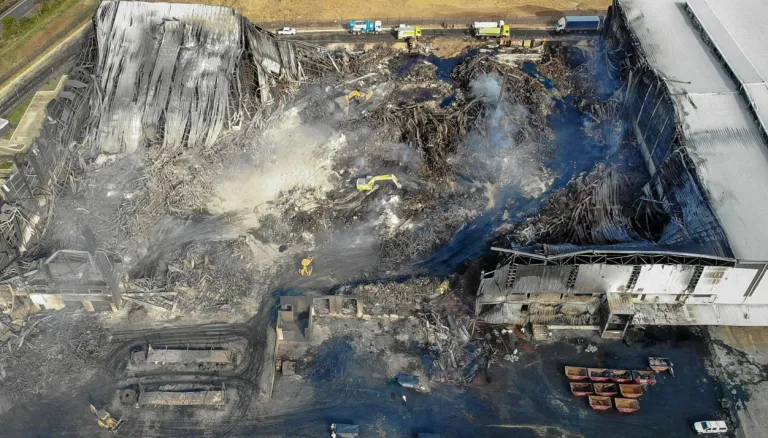
A drone image showing the extent of the damage caused to the UPL warehouse north of Durban, 21 July 2021. (Photo: Shiraaz Mohamed)
By Tony Carnie | 09 Apr 2024
Large numbers of fish washed up dead in the Ohlanga River estuary and along popular Umhlanga swimming beaches over the weekend. Days later, the UPL pesticides and agrochemicals group confirmed it had altered its water discharge records, saying it was correcting discrepancies.
______________________________________________________________________________________________________________________________
In the wake of another major fish kill in the Ohlanga River estuary in Durban, a consultant for the UPL pesticides and agrochemicals group has confirmed that records of the company’s treated water discharges into the river have been altered substantially.
The data “corrections” were made on Tuesday, 9 April 2024, several days after large numbers of marine and freshwater fish washed up dead in the estuary and along popular Umhlanga swimming beaches over the weekend.
These revisions to UPL’s previously reported water discharge readings came to light after Daily Maverick received information that significant volumes of treated water from the company’s pollution control dam in Cornubia were released into the river over a three-day period immediately prior to the fish kill.
However, UPL has insisted that there is no link between these events and has issued a media statement suggesting that untreated sewage leaks from the eThekwini municipality are most likely to blame for the fish kill.
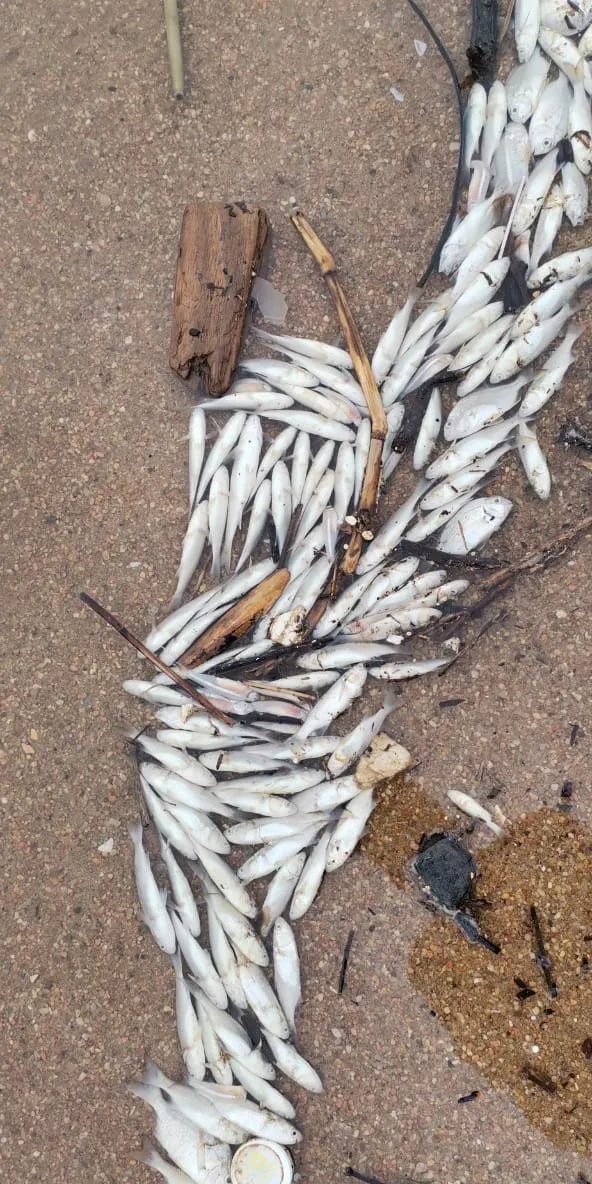
Dead fish in the Ohlanga River estuary in Durban. (Photo: Supplied)
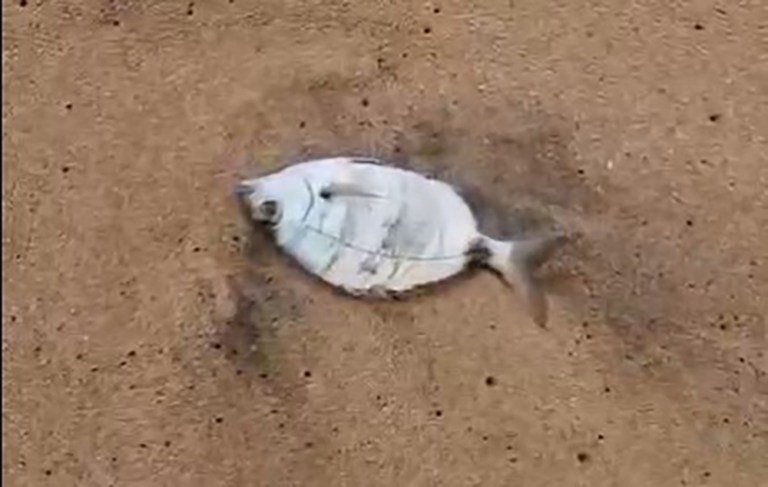
Dead fish on the Umhlanga tourist beach near Granny’s Pool. (Photo: Supplied)
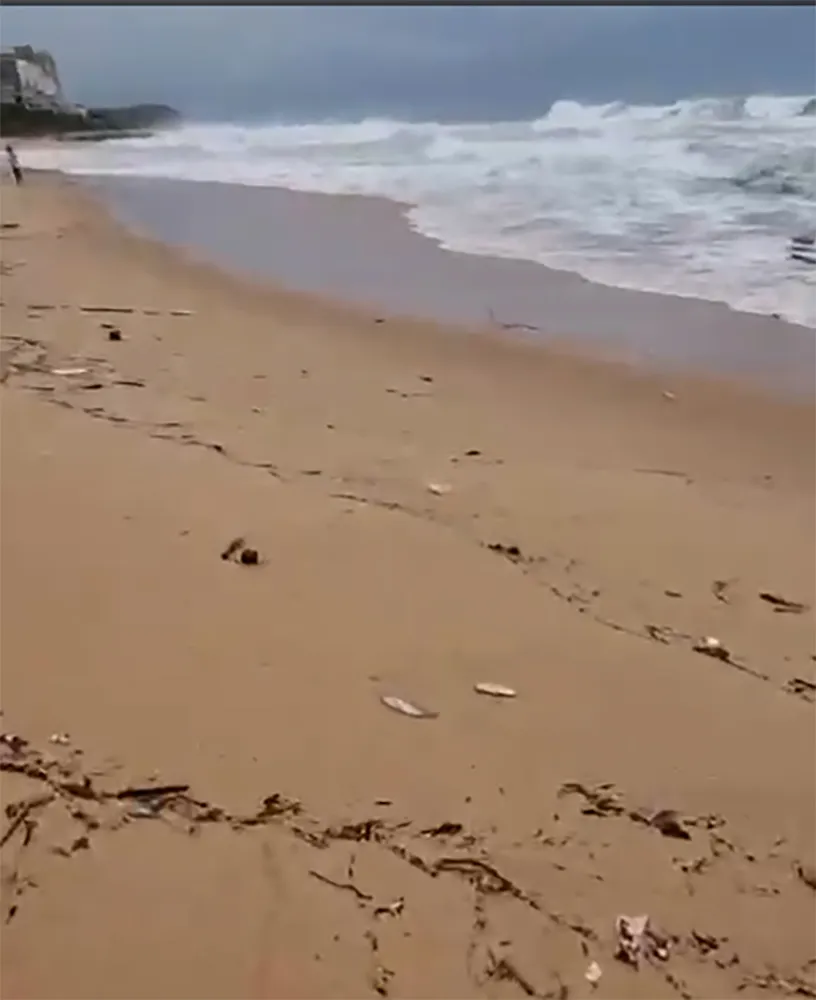
Dead fish on the Umhlanga tourist beach near Granny’s Pool. (Photo: Supplied)
Read more in Daily Maverick: UPL asked to explain how ‘Agent Orange’ war poison chemical ended up in Durban river
To verify the information we received about the high volume of treated water released from the UPL facility, we asked the company to provide us with its own official data for the last three weeks.
This treatment facility, housed in mobile shipping containers at Cornubia, uses ultraviolet light, ozone and other treatment methods to purify pesticide-polluted stormwater emanating from the soil and gutted remnants of the UPL chemical warehouse set alight by arsonists in the July 2021 riots.
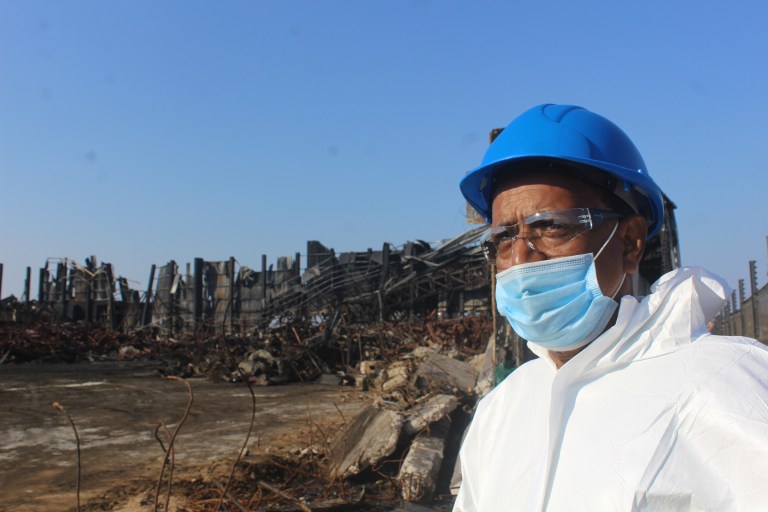
Environmental activist Desmond D’Sa at the burnt UPL warehouse. (Photo: Tony Carnie)
More than 4,000 tonnes of pesticides and other farm products were set alight during the arson attack.
However, the eThekwini municipality has expressed strong concerns about whether the treatment process is adequate to avoid further toxic pollution of land and rivers downstream of the pollution control dam – and launched an urgent high court application late last year to halt any further treated water releases from UPL.
Following a court-mediated process, the national department of water and sanitation (DWS) granted an “emergency permit” to the company to continue releasing treated water into a stream feeding the Ohlange River – subject to certain conditions and pending an official application to the DWS for a water use licence and a stormwater discharge permit from eThekwini.
We sent a request to UPL for its official treated water discharge data shortly after noon on 8 April. This data is tabulated and updated on a daily basis on a digital “dashboard” managed by UPL’s Pietermaritzburg-based freshwater ecology consultants, GroundTruth.
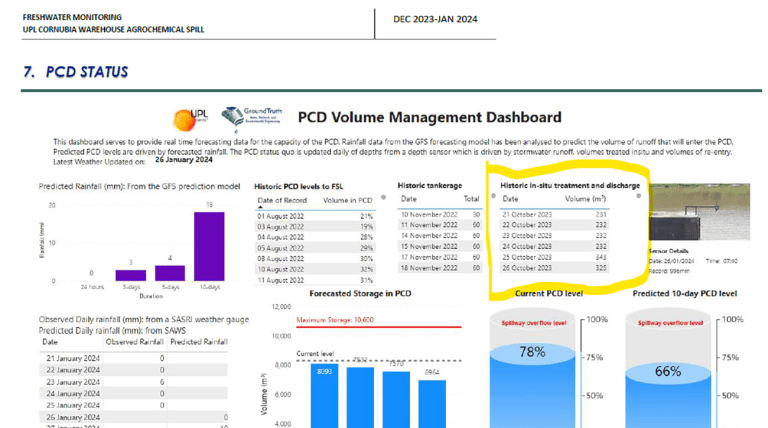
A screenshot of the UPL GroundTruth volume management “dashboard” showing historic treatment volumes from October last year. (Supplied)
More than 24 hours later, UPL finally supplied the requested data – but Daily Maverick soon picked up several discrepancies between the new UPL data and previous versions loaded on to the digital dashboard.
The new discharge volumes provided by UPL for the days immediately preceding the fish kill were substantially less than half the volume previously recorded on the UPL dashboard.
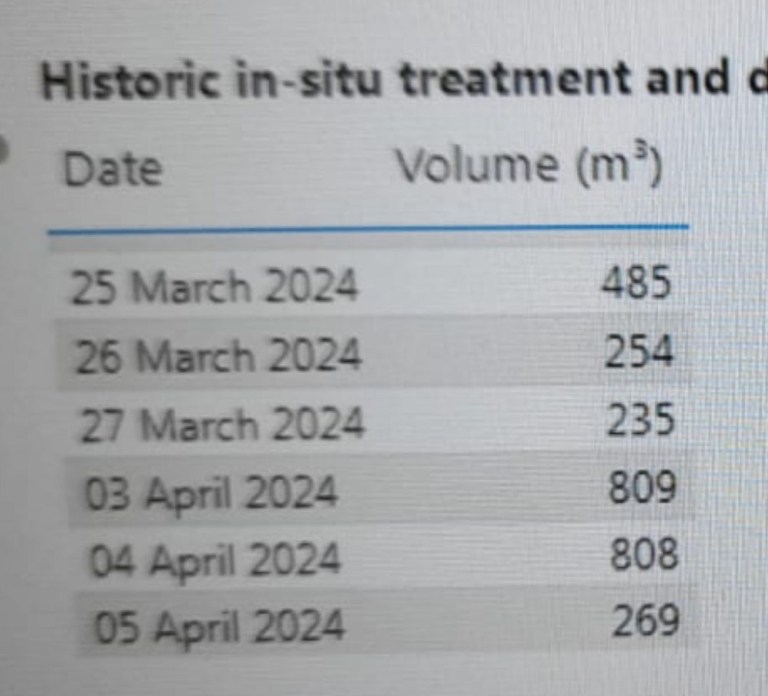
These are some of the (initial) treated water discharge volumes reported on UPL’s digital dashboard between March and April 2024. (Supplied)
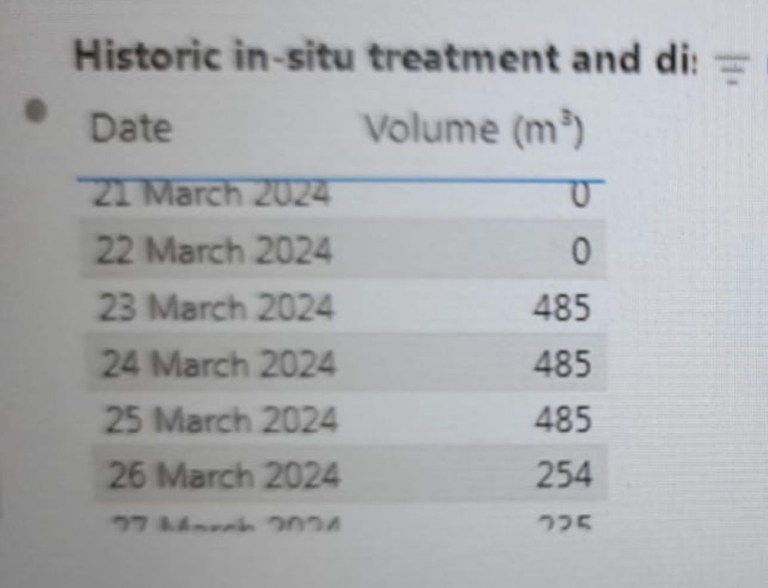
These are some of the (initial) treated water discharge volumes reported on UPL’s digital dashboard between March and April 2024. (Supplied)
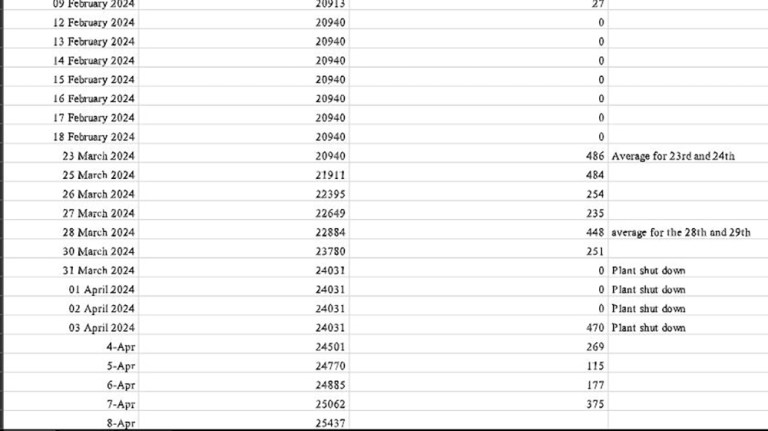
The “corrected” water discharge figures supplied by UPL. (Supplied)
When we asked UPL legal representative Norman Brauteseth to explain these apparent discrepancies, he referred us to GroundTruth director Dr Mark Graham.
Graham confirmed that the data had indeed been “corrected” on 9 April, several days after the fish kill was reported.
Asked on Tuesday to explain the reasons for the changes, Graham said that a plant operator at the site manually recorded daily input and discharge volumes at the treatment facility.
The plant engineer also visited the site on a regular basis to record data, by photographing the water flow meter before transmitting the data to GroundTruth staff for uploading to the digital dashboard.
However, said Graham, due to fluctuating work commitments, the plant engineer was not always able to visit the plant at the same time every day – or even on a daily basis – to photograph the flow meter.
For example, said Graham, the engineer might visit the treatment plant at 8am on a Monday and then again at 5.30pm on a Tuesday, or possibly only at some point on a Wednesday.
As a result, the photographic records of the flow meter data did not always accurately capture the specific 24-hour time windows reported on the digital dashboard.
This was the reason the official data had now been revised and “updated”, to more accurately record the average flow volumes over recent 24-hour time windows.
We asked Graham when the data was revised.
“Today,” he said.
Graham added that the figures recorded on the dashboard were merely a provisional or “broad summary indication” of daily flow volumes as there was no electronic transmission of real-time data to the dashboard.
“It could be two to three days between the images and it could be 56 hours.”
Apparently reiterating the message of the UPL media statement blaming sewage for the fish kill, Graham said that “abundant” fish populations had been seen and recorded at three sites in the upper reaches of the estuary closer to the old UPL warehouse.
eThekwini sent us a more cautious response: “The matter is currently under investigation and the City cannot give a response based on speculation. We will await the test results from our trusted laboratory and then respond accordingly.”
The Mumbai-based agrochemicals group has also issued a statement via its corporate communications consultant, Gerhard Mulder of Resolve Communications:
“UPL South Africa shares public concern over the fish die-off recorded on the beach at the Ohlanga Estuary mouth over the weekend of April 5 to 7, which preliminary analysis suggests was caused by untreated sewage overflows, rather than substances relating to the 2021 spill.
“On Saturday, April 6, an independent environmental expert in collaboration with a Department of Water and Sanitation official investigated an area stretching from upstream of the leased UPL Cornubia site to the Ohlanga River and down to [the] start of the estuary.
“Their findings showed 100% dissolved oxygen levels upstream and downstream of the UPL site. However, testing showed a significant drop to 65% dissolved oxygen in the Ohlanga River below Blackburn village at the bridge, pointing to a factor in that area potentially affecting the river’s health.
“Further investigations revealed that a sewage overflow had occurred from the Blackburn sewage pump station and was the likely cause of low oxygen levels in this point of the river.
“This, along with the high levels of ammonia typically found in sewage, potentially led to the fish die-off,” said the statement.
“Workers at the Blackburn sewage pump station confirmed that overflow occurred between Friday, April 5, and Saturday, April 6, and was a regular occurrence. On Monday, it came to light that further similar infrastructure failures may have occurred at the Siyaba Node 2 and Waterloo sewage plants.
“In this context, UPL South Africa has again expressed concern to the municipality regarding the recurring sewage infrastructure issues.
“The elevated level of sewage is having a negative impact on the ongoing environmental remediation efforts of the Ohlanga River and the local aquatic ecosystem.
“This can only be addressed through improved communication and action from the municipality to prevent future incidents to ensure the health of the Ohlanga River and its surroundings.” DM

A drone image showing the extent of the damage caused to the UPL warehouse north of Durban, 21 July 2021. (Photo: Shiraaz Mohamed)
By Tony Carnie | 09 Apr 2024
Large numbers of fish washed up dead in the Ohlanga River estuary and along popular Umhlanga swimming beaches over the weekend. Days later, the UPL pesticides and agrochemicals group confirmed it had altered its water discharge records, saying it was correcting discrepancies.
______________________________________________________________________________________________________________________________
In the wake of another major fish kill in the Ohlanga River estuary in Durban, a consultant for the UPL pesticides and agrochemicals group has confirmed that records of the company’s treated water discharges into the river have been altered substantially.
The data “corrections” were made on Tuesday, 9 April 2024, several days after large numbers of marine and freshwater fish washed up dead in the estuary and along popular Umhlanga swimming beaches over the weekend.
These revisions to UPL’s previously reported water discharge readings came to light after Daily Maverick received information that significant volumes of treated water from the company’s pollution control dam in Cornubia were released into the river over a three-day period immediately prior to the fish kill.
However, UPL has insisted that there is no link between these events and has issued a media statement suggesting that untreated sewage leaks from the eThekwini municipality are most likely to blame for the fish kill.

Dead fish in the Ohlanga River estuary in Durban. (Photo: Supplied)

Dead fish on the Umhlanga tourist beach near Granny’s Pool. (Photo: Supplied)

Dead fish on the Umhlanga tourist beach near Granny’s Pool. (Photo: Supplied)
Read more in Daily Maverick: UPL asked to explain how ‘Agent Orange’ war poison chemical ended up in Durban river
To verify the information we received about the high volume of treated water released from the UPL facility, we asked the company to provide us with its own official data for the last three weeks.
This treatment facility, housed in mobile shipping containers at Cornubia, uses ultraviolet light, ozone and other treatment methods to purify pesticide-polluted stormwater emanating from the soil and gutted remnants of the UPL chemical warehouse set alight by arsonists in the July 2021 riots.

Environmental activist Desmond D’Sa at the burnt UPL warehouse. (Photo: Tony Carnie)
More than 4,000 tonnes of pesticides and other farm products were set alight during the arson attack.
However, the eThekwini municipality has expressed strong concerns about whether the treatment process is adequate to avoid further toxic pollution of land and rivers downstream of the pollution control dam – and launched an urgent high court application late last year to halt any further treated water releases from UPL.
Following a court-mediated process, the national department of water and sanitation (DWS) granted an “emergency permit” to the company to continue releasing treated water into a stream feeding the Ohlange River – subject to certain conditions and pending an official application to the DWS for a water use licence and a stormwater discharge permit from eThekwini.
We sent a request to UPL for its official treated water discharge data shortly after noon on 8 April. This data is tabulated and updated on a daily basis on a digital “dashboard” managed by UPL’s Pietermaritzburg-based freshwater ecology consultants, GroundTruth.

A screenshot of the UPL GroundTruth volume management “dashboard” showing historic treatment volumes from October last year. (Supplied)
More than 24 hours later, UPL finally supplied the requested data – but Daily Maverick soon picked up several discrepancies between the new UPL data and previous versions loaded on to the digital dashboard.
The new discharge volumes provided by UPL for the days immediately preceding the fish kill were substantially less than half the volume previously recorded on the UPL dashboard.

These are some of the (initial) treated water discharge volumes reported on UPL’s digital dashboard between March and April 2024. (Supplied)

These are some of the (initial) treated water discharge volumes reported on UPL’s digital dashboard between March and April 2024. (Supplied)

The “corrected” water discharge figures supplied by UPL. (Supplied)
When we asked UPL legal representative Norman Brauteseth to explain these apparent discrepancies, he referred us to GroundTruth director Dr Mark Graham.
Graham confirmed that the data had indeed been “corrected” on 9 April, several days after the fish kill was reported.
Asked on Tuesday to explain the reasons for the changes, Graham said that a plant operator at the site manually recorded daily input and discharge volumes at the treatment facility.
The plant engineer also visited the site on a regular basis to record data, by photographing the water flow meter before transmitting the data to GroundTruth staff for uploading to the digital dashboard.
However, said Graham, due to fluctuating work commitments, the plant engineer was not always able to visit the plant at the same time every day – or even on a daily basis – to photograph the flow meter.
For example, said Graham, the engineer might visit the treatment plant at 8am on a Monday and then again at 5.30pm on a Tuesday, or possibly only at some point on a Wednesday.
As a result, the photographic records of the flow meter data did not always accurately capture the specific 24-hour time windows reported on the digital dashboard.
This was the reason the official data had now been revised and “updated”, to more accurately record the average flow volumes over recent 24-hour time windows.
We asked Graham when the data was revised.
“Today,” he said.
Graham added that the figures recorded on the dashboard were merely a provisional or “broad summary indication” of daily flow volumes as there was no electronic transmission of real-time data to the dashboard.
“It could be two to three days between the images and it could be 56 hours.”
Apparently reiterating the message of the UPL media statement blaming sewage for the fish kill, Graham said that “abundant” fish populations had been seen and recorded at three sites in the upper reaches of the estuary closer to the old UPL warehouse.
eThekwini sent us a more cautious response: “The matter is currently under investigation and the City cannot give a response based on speculation. We will await the test results from our trusted laboratory and then respond accordingly.”
The Mumbai-based agrochemicals group has also issued a statement via its corporate communications consultant, Gerhard Mulder of Resolve Communications:
“UPL South Africa shares public concern over the fish die-off recorded on the beach at the Ohlanga Estuary mouth over the weekend of April 5 to 7, which preliminary analysis suggests was caused by untreated sewage overflows, rather than substances relating to the 2021 spill.
“On Saturday, April 6, an independent environmental expert in collaboration with a Department of Water and Sanitation official investigated an area stretching from upstream of the leased UPL Cornubia site to the Ohlanga River and down to [the] start of the estuary.
“Their findings showed 100% dissolved oxygen levels upstream and downstream of the UPL site. However, testing showed a significant drop to 65% dissolved oxygen in the Ohlanga River below Blackburn village at the bridge, pointing to a factor in that area potentially affecting the river’s health.
“Further investigations revealed that a sewage overflow had occurred from the Blackburn sewage pump station and was the likely cause of low oxygen levels in this point of the river.
“This, along with the high levels of ammonia typically found in sewage, potentially led to the fish die-off,” said the statement.
“Workers at the Blackburn sewage pump station confirmed that overflow occurred between Friday, April 5, and Saturday, April 6, and was a regular occurrence. On Monday, it came to light that further similar infrastructure failures may have occurred at the Siyaba Node 2 and Waterloo sewage plants.
“In this context, UPL South Africa has again expressed concern to the municipality regarding the recurring sewage infrastructure issues.
“The elevated level of sewage is having a negative impact on the ongoing environmental remediation efforts of the Ohlanga River and the local aquatic ecosystem.
“This can only be addressed through improved communication and action from the municipality to prevent future incidents to ensure the health of the Ohlanga River and its surroundings.” DM
"Education is the most powerful weapon which you can use to change the world." Nelson Mandela
The desire for equality must never exceed the demands of knowledge
The desire for equality must never exceed the demands of knowledge
- Lisbeth
- Site Admin
- Posts: 67571
- Joined: Sat May 19, 2012 12:31 pm
- Country: Switzerland
- Location: Lugano
- Contact:
Re: The State of The Rivers/Oceans/Water/Air
For how long is this disaster going to last? 
"Education is the most powerful weapon which you can use to change the world." Nelson Mandela
The desire for equality must never exceed the demands of knowledge
The desire for equality must never exceed the demands of knowledge
- Lisbeth
- Site Admin
- Posts: 67571
- Joined: Sat May 19, 2012 12:31 pm
- Country: Switzerland
- Location: Lugano
- Contact:
Re: The State of The Rivers/Oceans/Water/Air
UP TO THEIR NECKS IN IT
High court orders Nkomazi Municipality to stop fouling Komatipoort, Crocodile River with sewage
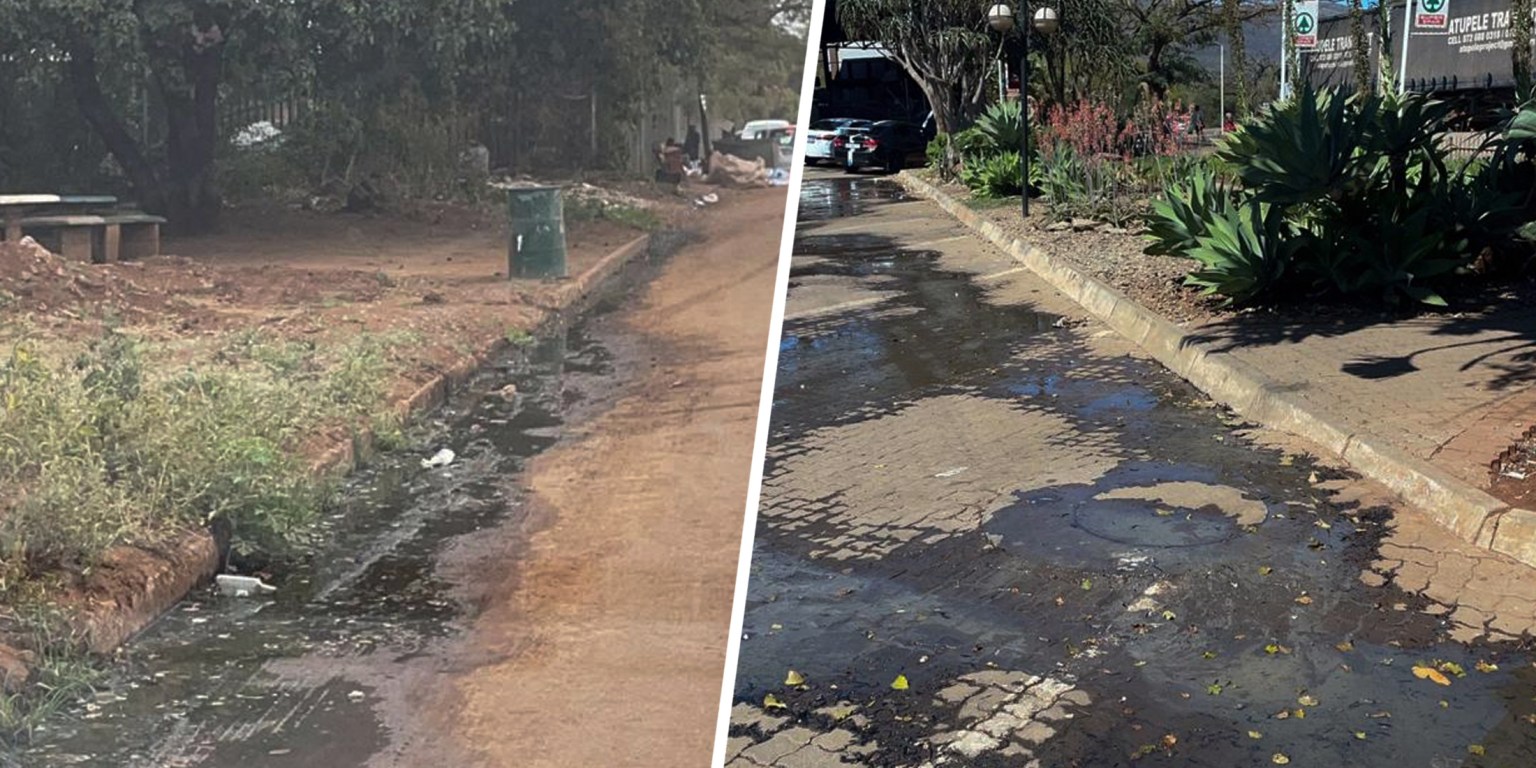
Raw sewage runs down a street in Komatipoort. | Raw sewage spills out near the town's Spar. (Photos: Lené Roux, Komatipoort Despondent Residents Association)
By Ed Stoddard | 21 Apr 2024
The Mpumalanga High Court ordered the Nkomazi Municipality on Friday to urgently take remedial action to stop the flow of raw sewage that is fouling the tourist town of Komatipoort and the Crocodile River and to clean up the mess within 21 days.
_____________________________________________________________________________________________________________________
Faced with evidence of extensive sewage pollution throughout Komatipoort, the Mpumalanga High Court on Friday ordered the Nkomazi Municipality to clean up its act and the streets.
“The waste disposal sites and sewerage works in Komatipoort are not well managed and therefore need urgent attention as these are the causes of the sewage spills encountered,” the judgment reads.
It ordered the first three respondents – the municipality, the municipal manager and the mayor – to “urgently take remedial steps to stop the raw sewage spills by immediately fixing the causes of the spillages and to remedy the effects of the pollution caused, and to rehabilitate the affected areas”.
The respondents were ordered to file a report to the registrar of the court within 21 days on the steps taken on that front. The municipal manager was ordered to ensure that the raw sewage spilling into the Crocodile River is “cleared up within 21 calendar days from the date of the order”.
Chronic water shortages have also bedevilled the town and the municipality was ordered to comply with its constitutional obligation to supply potable water.
The municipality has not yet responded to a request for comment.
The applicant in the case, the Komatipoort Despondent Residents Association, was authorised by the court to employ an expert to monitor the sewerage works for 12 weeks, for which the municipality will have to pay.
Association chairperson Lené Roux told Daily Maverick that the problem had been festering for years.
“We are struggling to cope with sewage spilling everywhere, and the smell. We have a family guesthouse, it overlooks the Kruger Park, and some days you can smell the sewage in the dining room and the bedrooms,” she said.
In 2019, the South African Human Rights Commission found that Nkomazi and two other Mpumalanga municipalities were in violation of the “Constitution as a result of their continued failure to effectively address the challenges of sewage spillages and the inadequate treatment of effluent within their jurisdictions”.
It also found that they had contravened the National Water Act and the National Environmental Management Act owing to their “failure to prevent and remedy the effects of environmental pollution, in the course of providing sanitation services to their residents”.
Five years later, a sewer is still running through Komatipoort, which is an ANC-run municipality.
The spill into the Crocodile River is deeply concerning because it flows into Mozambique, taking “made in South Africa” pollution into a neighbouring country. The river is also home to a wide range of fish and bird life as well as crocodiles and hippos.
This example of state failure is one of many fouling South African waterways and towns, creating a health hazard for humans while damaging ecosystems and threatening wildlife.
It’s also not the first time a South African court has ordered a delinquent municipality to stop a torrent of raw sewage caused by its negligence.
It remains to be seen whether the Nkomazi Municipality has the capacity or funds to address this issue as the court has ordered. DM
High court orders Nkomazi Municipality to stop fouling Komatipoort, Crocodile River with sewage

Raw sewage runs down a street in Komatipoort. | Raw sewage spills out near the town's Spar. (Photos: Lené Roux, Komatipoort Despondent Residents Association)
By Ed Stoddard | 21 Apr 2024
The Mpumalanga High Court ordered the Nkomazi Municipality on Friday to urgently take remedial action to stop the flow of raw sewage that is fouling the tourist town of Komatipoort and the Crocodile River and to clean up the mess within 21 days.
_____________________________________________________________________________________________________________________
Faced with evidence of extensive sewage pollution throughout Komatipoort, the Mpumalanga High Court on Friday ordered the Nkomazi Municipality to clean up its act and the streets.
“The waste disposal sites and sewerage works in Komatipoort are not well managed and therefore need urgent attention as these are the causes of the sewage spills encountered,” the judgment reads.
It ordered the first three respondents – the municipality, the municipal manager and the mayor – to “urgently take remedial steps to stop the raw sewage spills by immediately fixing the causes of the spillages and to remedy the effects of the pollution caused, and to rehabilitate the affected areas”.
The respondents were ordered to file a report to the registrar of the court within 21 days on the steps taken on that front. The municipal manager was ordered to ensure that the raw sewage spilling into the Crocodile River is “cleared up within 21 calendar days from the date of the order”.
Chronic water shortages have also bedevilled the town and the municipality was ordered to comply with its constitutional obligation to supply potable water.
The municipality has not yet responded to a request for comment.
The applicant in the case, the Komatipoort Despondent Residents Association, was authorised by the court to employ an expert to monitor the sewerage works for 12 weeks, for which the municipality will have to pay.
Association chairperson Lené Roux told Daily Maverick that the problem had been festering for years.
“We are struggling to cope with sewage spilling everywhere, and the smell. We have a family guesthouse, it overlooks the Kruger Park, and some days you can smell the sewage in the dining room and the bedrooms,” she said.
In 2019, the South African Human Rights Commission found that Nkomazi and two other Mpumalanga municipalities were in violation of the “Constitution as a result of their continued failure to effectively address the challenges of sewage spillages and the inadequate treatment of effluent within their jurisdictions”.
It also found that they had contravened the National Water Act and the National Environmental Management Act owing to their “failure to prevent and remedy the effects of environmental pollution, in the course of providing sanitation services to their residents”.
Five years later, a sewer is still running through Komatipoort, which is an ANC-run municipality.
The spill into the Crocodile River is deeply concerning because it flows into Mozambique, taking “made in South Africa” pollution into a neighbouring country. The river is also home to a wide range of fish and bird life as well as crocodiles and hippos.
This example of state failure is one of many fouling South African waterways and towns, creating a health hazard for humans while damaging ecosystems and threatening wildlife.
It’s also not the first time a South African court has ordered a delinquent municipality to stop a torrent of raw sewage caused by its negligence.
It remains to be seen whether the Nkomazi Municipality has the capacity or funds to address this issue as the court has ordered. DM
"Education is the most powerful weapon which you can use to change the world." Nelson Mandela
The desire for equality must never exceed the demands of knowledge
The desire for equality must never exceed the demands of knowledge


